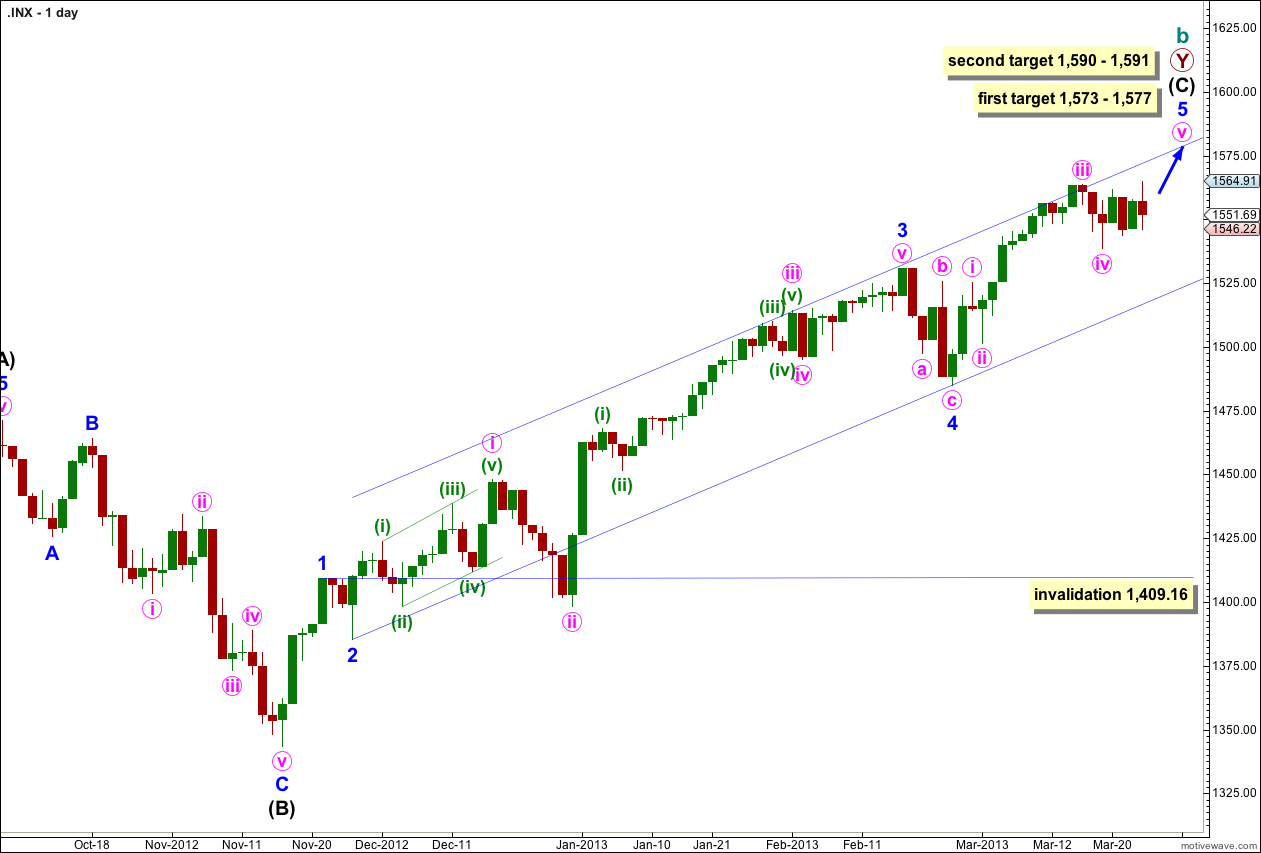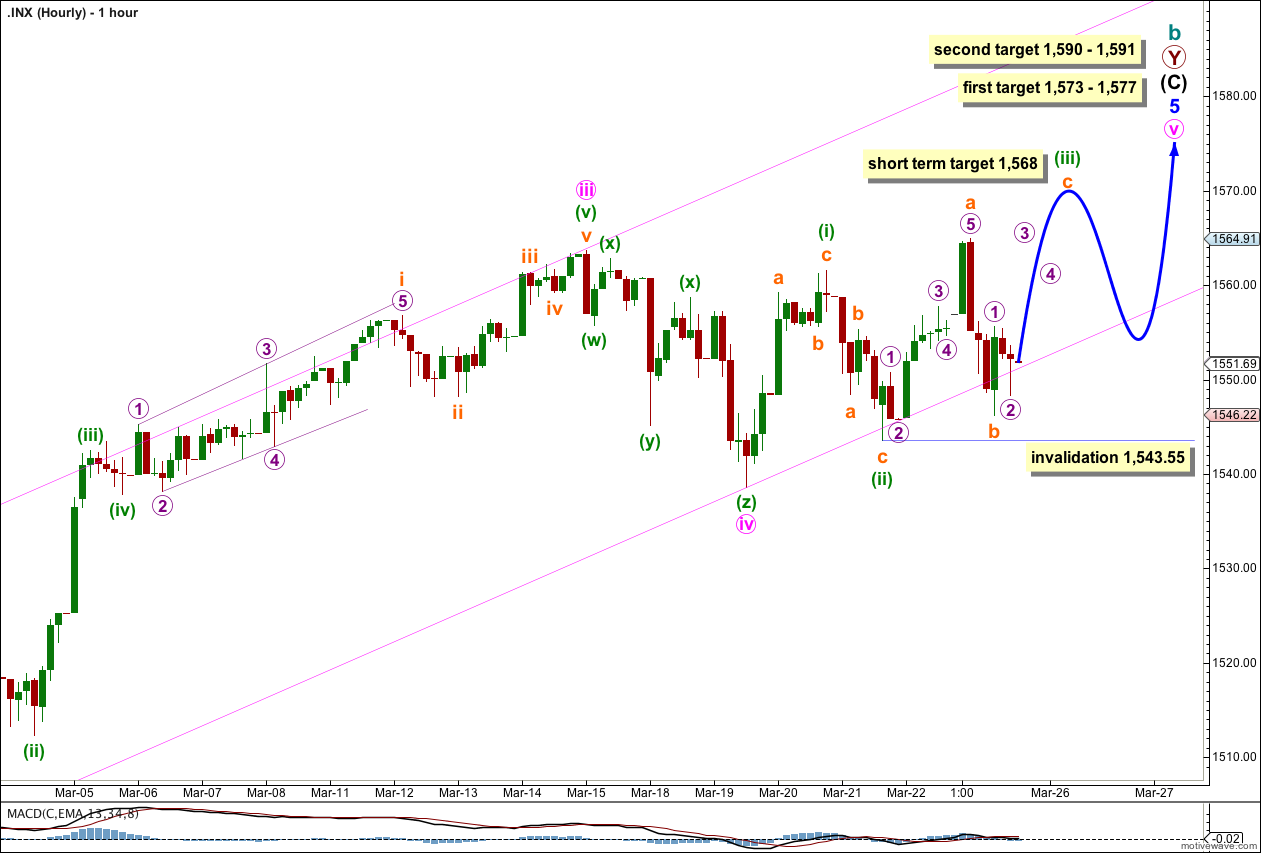Movement to a new high has invalidated the fourth wave triangle. However, the alternate hourly wave count does not have the right look.
I have adjusted the hourly wave count. It is very likely that the fourth wave is over. The only question now is on the structure of the fifth wave; it may be either an impulse or an ending diagonal.
Click on the charts below to enlarge.
The structure is within the second zigzag of a double labeled primary wave Y. Within this second zigzag intermediate wave (C) may be incomplete.
Within intermediate wave (C) minor waves 1 through to 4 are most likely complete. We may use Elliott’s channeling technique to draw a channel about the impulse of intermediate wave (C). Draw the first trend line from the lows of minor waves 2 to 4, then place a parallel copy upon the high of minor wave 3. At this stage it looks like minor wave 5 may end about the upper edge of this channel.
At 1,573 cycle wave b would reach 105% the length of cycle wave a. This is the minimum requirement for a B wave in relation to an A wave within an expanded flat, and as expanded flats are the most common type of flat this price point has a good probability of being reached.
At 1,575 minor wave 5 would reach 0.618 the length of minor wave 3.
At 1,577 minute wave v within minor wave 5 would reach 0.618 the length of minute wave iii.
If price continues to move higher through the first target then we may use the second target. At 1,590 intermediate wave (C) would reach 0.618 the length of intermediate wave (A). At 1,591 minor wave 5 would reach 1.618 the length of minor wave 1. This gives us a high probability two point target based upon three wave degrees.
Within intermediate wave (C) minor wave 4 may not move into minor wave 1 price territory. This wave count is invalidated with movement below 1,409.16.
Within intermediate wave (C) minor wave 1 has no Fibonacci duration lasting 4 days, minor wave 2 lasted a Fibonacci 3 days, minor wave 3 lasted a Fibonacci 55 days, and minor wave 4 lasted a Fibonacci 5 days. So far minor wave 5 has lasted 19 days and may be incomplete. A possible end may be at a Fibonacci 21 days which will be in another 2 sessions. If it does not end there then a further 13 sessions would take it to a Fibonacci 34. At each Fibonacci time duration I will look at the structure to see if it could be complete and if so we shall have an alternate wave count for that possibility.
At intermediate degree wave (C) has so far lasted 86 sessions. In another 3 sessions it will have lasted a Fibonacci 89.
The most likely end to this trend may be 27th March, 2013 (give or take one day either side). However, Fibonacci time relationships are not always reliable. This is a guideline only!
If this trend does not end this week on the 27th of March the next possible date would be 17th April.
It seems clear now that minute wave iv is over as a triple zigzag.
The recent choppy overlapping upwards movement is trending slightly higher. This may be an ending diagonal. Within an ending diagonal all subwaves must subdivide into zigzags. Within minuette wave (i) the structure subdivides best on the five minute chart as a zigzag. Within minuette wave (iii) the upwards movement labeled subminuette wave a subdivides best as an impulse, so this would be just wave a within minuette wave (iii). Subminuette wave b subdivides perfectly as a zigzag on the five minute chart.
At 1,568 subminuette wave c would reach equality with subminuette wave a within the zigzag of minuette wave (iii).
Within minuette wave (iii) if subminuette wave b moves lower it may not move beyond the start of subminuette wave a at 1,543.55.
The diagonal would most likely be expanding. When minuette wave (iii) is complete then minuette wave (iv) should overlap back into minuette wave (i) price territory, but may not move beyond the end of minuette wave (ii) below 1,543.55. Minuette wave (iv) should be longer than 18 points.
Minuette wave (v) does not have to make a new high, it may be truncated. If the diagonal is expanding it should be at least as long as minuette wave (iii).
This structure may take another two or three sessions to unfold.
I have considered alternates which would allow minute wave iv to be incomplete. It would be hugely out of proportion to minute wave ii and such a wave count would look strange. Also, I cannot find a suitable alternate which fits subdivisions.



Still on the bus … 1565 into your upper target
Lara, how come you are looking at an a, b, c within wave (iii) greeen. I thought a, b, c was corrective and could not occur in a wave (iii)?
A most excellent question.
The only time you will ever see a third wave labeled as anything other than an impulse is within a diagonal.
Within an ending diagonal all the subwaves, 1 through to 5, must be zigzags. This means you must have a third wave labeled as a zigzag.